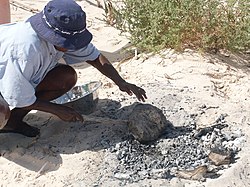Damper
Damper is, in the broadest sense, bread making by the Aborigines and Europeans in Australia . The main difference is that the Aborigines used seeds of portulaca and grass in the deserts and nuts in northern Australia, while the Europeans used flour. Nowadays the forms of production and the ingredients are variable.
history
Aboriginal women have made bush bread for millennia from seasonal seeds and nuts baked in the ashes of fires. Damper is also a bread baked by migrant workers, drovers and other travelers in the outback . It is made from flour that is traditionally baked on the coals of a campfire and called a damper. The flour that the Aborigines used in the past was not as fine as that of the Europeans and it was not just made from grain. Damper is now an Australian dish and is counted among the Bush Food .
Damper production
Aboriginal
Damper was baked in many different ways by the Aborigines, in the north of Australia there are more nutcakes than the seed damper in the deserts of Australia, where rice was also used. When Australia was colonized by the British, they offered flour, sugar, and tea to the indigenous people, which led to malnutrition, poor health, and obesity. In contrast to industrial flour, the nuts and seeds of the acacia and grass species have a high nutritional value, which enabled the Aborigines to move over long distances. Furthermore, in order to survive, the Aborigines were not only forced to eat contrary to their previous habits, but they also had to settle near settlements to get this food.
Damper was made by Aboriginal women mainly from nuts, portulaca plants and grass seeds. The collected seeds were usually ground in a bowl that was also used for digging. The impurities were then removed and the sleeves blown away by throwing them up. After cleaning, the seeds were mixed with water and ground with a stone, the resulting paste could be eaten immediately or it was formed into small loaves of bread and baked between charcoal. When the fire had burned long enough and the floor was hot enough, the charcoal was pushed aside, the bread was placed on the hot floor and small sprigs of mulga were laid out to give it aroma. Then the loaf of bread was surrounded by charcoal and baked for half an hour. If the damper was tapped and the resulting noise sounded hollow, the bread baked in this way was dark brown and tasty. It was like a taste of whole grains - rye bread .
There are other ways of production that differ marginally, for example when the Aboriginal people used flour, added milk or dried the paste on charcoal or ashes before baking.
Europeans
Damper was also baked by the British colonists and drovers ( Stockman ), who traveled to deserted areas for weeks and months with only a ration of flour, sugar and tea and supplemented this with meat, if available. The main ingredients of Damper are flour, water, salt and sometimes milk or coconut milk . Baking soda could be used as a leavening agent. The damper was usually not baked on the ashes of the campfire by the so-called Stockman's Damper , but placed directly on the hot charcoal and turned over and over again. This damper also sounds hollow when it's finished. It is hard and brown after baking. Alternatively, the damper is now also baked in a greased camping oven or on hot metal trays.
Current
Damper is also eaten with dried or cooked meat or with golden syrup ( sugar beet syrup ), which is also known as "cocky's joy" in Australia. It is now available in bakeries. Some variations and recipes exist, some are authentic, others use the name to market more rustic bread products in Australian cities.
There were numerous cookbooks in the early days of Australia that described damper making. Today, produced damper, enjoyed with tea made from billycans - preferably sweetened with bush chong - is a popular bush meal among the Aborigines and Australians of European origin.
Web links
Individual evidence
- ↑ Jennifer Isaacs: Bush Food. Aboriginal food and herbal medicine . Translated from the English by Barbara Rusch. Könnemann Verlagsgesellschaft, Cologne 2000. ISBN 3-8290-2191-7 . Pp. 115/116
- ↑ Jennifer Isaacs: Bush Food. Aboriginal food and herbal medicine . Translated from the English by Barbara Rusch. Könnemann Verlagsgesellschaft, Cologne 2000. ISBN 3-8290-2191-7 . Pp. 116/118
- ↑ a b Jennifer Isaacs: Bush Food. Aboriginal food and herbal medicine . Translated from the English by Barbara Rusch. Könnemann Verlagsgesellschaft, Cologne 2000. ISBN 3-8290-2191-7 . P. 119

